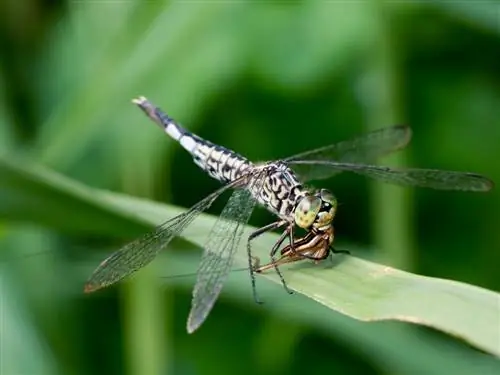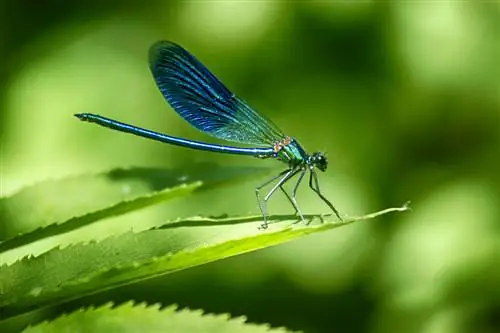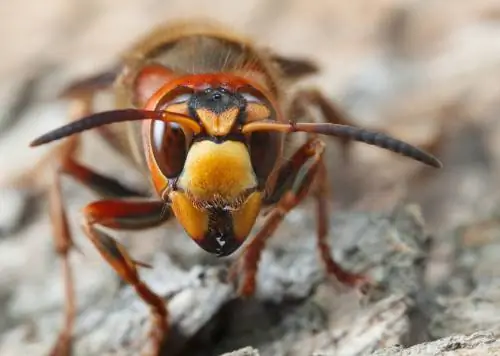- Author admin [email protected].
- Public 2023-12-16 16:46.
- Last modified 2025-01-23 11:22.
There is a persistent rumor that dragonflies can sting and bite. Terms like “devil’s needle” and “horse death” are doing the rounds. This causes uncertainty in the family garden and on the go when you cross paths with dragonflies. This guide lifts the veil of misconception that surrounds harmless dragonflies.

Can dragonflies sting people?
Dragonflies cannot sting because they only have a blunt ovipositor instead of a defensive stinger. They also don't bite people because they don't see them as enemies or prey. Dragonflies are also non-poisonous because they lack poison glands.
- Dragonflies don't sting. Females never use their blunt ovipositor as a defensive spine.
- Dragonflies don't bite. Mouthparts opened in extreme emergency can cause slight pinching in the worst case.
- Dragonflies are not poisonous because they do not have poison glands.
Dragonflies don’t sting
Dragonflies are superlative insects with breathtaking abilities. Stabbing is not one of them. In fact, an impressive spine can be seen at the end of the abdomen. Anyone who doesn't know what they're looking for will be frightened by this sight. Our ancestors were already convinced that such large stingers must be much more dangerous than small wasp or bee stingers. It's high time to put this misconception to rest. The following table sums up why dragonflies don't sting compared to other insects:
| Dragonflies | Wasps | Bees | Bumblebees | |
|---|---|---|---|---|
| Spine Shape | blunt | pointy | pointy | pointy |
| Spin function | laying drill | Wehrstabe | Wehrstabe | Wehrstabe |
| with poison gland | no | yes | yes | yes |
A chain of unfortunate misconceptions earned the dragonfly the second name “Devil’s Needle”. Everyone knows that a wasp sting can be very painful. A bee or bumblebee sting is also accompanied by symptoms that last for days. Huge dragonflies with unmistakable stingers are given the stamp of dangerous monster insects. Reality gives us a completely different picture.
Pacifists with ovipositors

What looks like a stinger is actually a laying tool
The stinger at the end of the segmented abdomen of some domestic dragonfly species is used exclusively for laying eggs. Furthermore, this pseudo-sting is blunt, so it cannot be considered a needle. The correct name is ovipositor. It is a tool for reproduction by placing fertilized eggs in soft substrate in or near water. This task falls to the females, so male dragonflies are born without ovipositors.
A blunt ovipositor cannot penetrate human skin, even if the dragonfly wanted to. However, the dazzlingly colorful helicopter has no such intention. Likewise, the good-natured insects do not seek the lives of horses. The term “horse death” therefore belongs in the land of fables. Dragonflies are among the pacifists in the insect kingdom, characterized by a friendly and shy disposition.
In ancient times, wasps, bees and bumblebees also had blunt ovipositors. However, evolution had other plans for the reproductive tools of this category of insects. In the course of development, the ovipositor transformed into a sharp, poisonous defensive stinger. For this reason, only queens and workers in the bee colony have a stinger, which unwary people occasionally feel. Males are left behind. Threats once did not have an ovipositor and today cannot boast of a defensive stinger.
Excursus
Shaking flight is not an attack
Dragonflies are daring aerial acrobats. Their impressive flying skills are the origin of a widespread misconception. Some dragonfly species reach top speeds of up to 50 km/h and can suddenly slow down from full flight. The insects remain shaking in the air and look at the surroundings with their furious compound eyes. Inquisitive dragonflies often use this flying technique to inspect a human visitor to their territory up close. Unfortunately, the ingenious shaking flight is misunderstood by many people as an attack, followed by fatal counter-reactions to the chagrin of the curious dragonflies.
Dragonflies don’t bite

Dragonflies use their sharp mouthparts to crack chitinous shells; they cannot bite humans
With their powerful mouthparts, dragonflies can crack almost any insect shell. In fact, there are pointed teeth with sharp edges in the upper jaw that effortlessly grind down any prey. These solid jaws are the source of the myth of aggressive dragonflies that moodily look for humans to bite them. It's true: dragonflies don't bite. The following connections explain why this is so:
- Human skin is too thick for serious injuries from dragonfly teeth
- Mouthparts are primarily used to absorb food
- Dragonflies only use their jaws for defense in extreme emergencies
From the perspective of their compound eyes, humans are not enemies and certainly not prey for dragonflies. The mouth therefore remains tightly closed, even when a tired dragonfly sits down on its arm, hand or leg to rest. However, anyone who presses or squeezes the harmless natural gem should not be surprised if they get bitten. There is no need to fear serious consequences, such as those caused by a spider bite. Rather, those affected notice a slight pinch before the dragonfly, severely disappointed by the human, rises into the air.
Tip
The film “Kings for a Summer” from Libellen.tv offers a fascinating foray into the lives of dragonflies. For three years, the insect friends followed the growth and decline of the dragonfly kingdom. The film is available on DVD, Blue Ray and DVD-9 at a price of 15.95 euros. An exciting pleasure for the whole family.
Dragonflies are not poisonous
Poison is a foreign word for dragonflies. The picturesque beauties do not have any poison glands on the ovipositor, which would be counterproductive in the immediate vicinity of valuable insect eggs. Furthermore, dragonflies do not inject toxic substances with their mouthparts. Direct contact with the iridescent body poses no danger to people or pets.
Tips for a dragonfly-friendly garden
Once the veil of errors and false suspicions has been lifted, an invaluable natural gem emerges. In the natural garden, dragonflies make a free contribution to ecological pest control. The peaceful coffee table without annoying mosquitoes and flies is thanks to busy dragonflies in the garden. The colorful insects offer captivating spectacles with romantic wedding dances and thrilling territorial battles. Good reasons for a garden that invites dragonflies to linger. These components include:
- clean water: standing or flowing water without artificial additives, such as chlorine
- lush planting: varied plant species on the bank and on the water surface
- free pond areas: balanced combination of free and green pond areas
- sufficient water depth: a water zone with at least 80 cm depth in the garden pond
- no pesticides: consistent avoidance of insecticides, fungicides, herbicides and chemical fertilizers
Basically, dragonflies are happy with any type of water in the garden with natural conditions and dense bank vegetation. Most female dragonflies lay their eggs in water. After a development period of three months to five years, the adult larvae leave the pond to hatch on stems and leaves near the bank.
Frequently asked questions
Can dragonflies sting cats?

Cats can be dangerous to dragonflies, not the other way around
Dragonflies do not have a defensive stinger. What appears to be a poisonous stinger at the end of the abdomen is actually a blunt ovipositor. For this reason, harmless dragonflies cannot sting cats, dogs or even people. Conversely, the situation looks different. If a flying or shaking dragonfly awakens a cat's hunting instinct, it doesn't end well for the dragonfly.
How long do dragonflies live?
Dragonflies spend most of their lives as larvae in water. In Central Europe, this phase extends from three months, like the early darter (Sympetrum fonscolombii), to five years, like the genus of spring damselflies (Cordulegaster). As adults, the insects live an average of six to eight weeks. The Methuselahs among the European species are the winter dragonflies (Sympecma) with a lifespan of ten to eleven months as adults. However, winter dragonflies remain frozen for between four and six months of their lives.
Where can you watch dragonflies?
The best prospects for observing dragonflies in their natural habitat are near stagnant or slow-flowing water. Some dragonflies, such as the wonderful blue-green mosaic damselflies (Aeshna cyanea), also like to stay away from bodies of water, such as in densely green residential areas or allotment garden colonies. For most European species, biotopes, lakes and ponds with lush bank vegetation are the most popular habitats.
Is it true that seven dragonfly stings can kill a person or a horse?
This claim has no basis and comes from a time when people still believed in witches and wizards. The fact is that dragonflies don't sting because they don't have a defensive stinger. At the end of their long, slender body there is a blunt ovipositor that is used solely to place eggs. Furthermore, peaceful, friendly dragonflies do not dream of stinging people, horses or other warm-blooded animals.
A dragonfly often sits in the garden with its wings hanging down and its abdomen stretched out. Does the dragonfly want to sting me?
No, you are describing a special position that dragonflies take to warm up. As cold-blooded insects, dragonflies first have to soak up warm sunlight in order to be active. To do this, they point their abdomen towards the sun and lower their wings. It is therefore not a threatening gesture, because dragonflies are peaceful fellows and cannot sting.
Can you catch dragonflies?
All dragonfly species are protected and may not be caught. Of 80 European species, two thirds are critically endangered and 20 percent are threatened with extinction. In the last 60 years, two irreplaceable dragonfly species have disappeared forever. In order to draw attention to the threatening situation of these beautiful insects, the German Nature Conservation Union (NABU) and the Society of German-Speaking Odonatologists (GdO) nominate a Dragonfly of the Year every year.
Tip
Even in their tender larval age, dragonflies hunt for annoying insects and caterpillars of all kinds. As lurking hunters, dragonfly larvae float on the surface of the water and look out for mosquito larvae, water fleas and other prey. Potential victims are captured with a mask and eaten.






